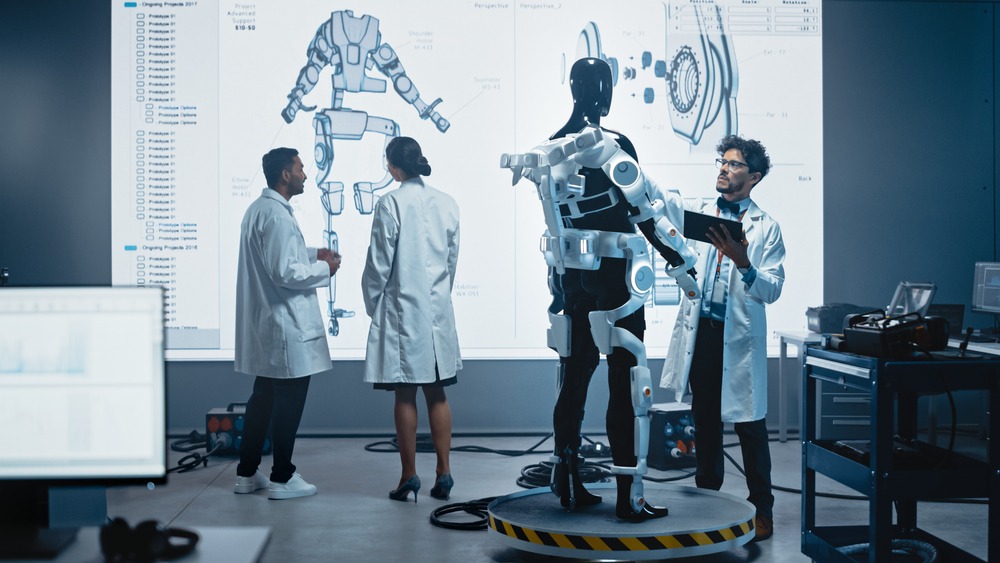Robotics engineering is one of the most exciting and rapidly growing fields in technology. From self-driving cars and industrial automation to medical robots and AI-powered assistants, robotics is shaping the future.
If you’re fascinated by robotics, AI, and automation, this guide will show you how to become a robotics engineer, step by step. Whether you’re a student, a career changer, or an enthusiast, this roadmap will help you break into this exciting industry.
1. What is Robotics Engineering? 🤖
A robotics engineer designs, builds, programs, and maintains robots. These professionals work at the intersection of mechanical engineering, electrical engineering, and computer science to create intelligent machines that assist humans in various industries.
🔹 What Do Robotics Engineers Do?
✅ Design & Build Robots – Create mechanical structures, actuators, and sensors.
✅ Develop AI & Machine Learning Systems – Program robots to learn and adapt.
✅ Test & Maintain Robotics Systems – Ensure functionality and efficiency.
✅ Work in Industries Like – Healthcare, space exploration, defense, manufacturing, and consumer electronics.
Now, let’s break down how you can become a robotics engineer. 🚀
2. Step-by-Step Guide to Becoming a Robotics Engineer 🛠️
🔹 Step 1: Develop a Strong Foundation in Math & Science 📐
Robotics relies heavily on mathematics, physics, and engineering principles.
Start by mastering these subjects in high school or through online courses:
✅ Mathematics: Algebra, Trigonometry, Calculus, and Linear Algebra.
✅ Physics: Mechanics, Kinematics, and Electricity.
✅ Programming: Python, C++, or Java.
✅ Computer Science & Electronics Basics.
🛠 Resources to Learn Online:
- Khan Academy (Math & Physics)
- Coursera / edX (Intro to Robotics Courses)
- Harvard CS50 (Computer Science Fundamentals)
🔹 Step 2: Get a Degree in Robotics or a Related Field 🎓
Most robotics engineers have a Bachelor’s degree in:
✅ Robotics Engineering
✅ Mechanical Engineering
✅ Electrical / Electronics Engineering
✅ Computer Science / AI
💡 Some universities offer specialized robotics programs, but you can still enter the field with a mechanical, electrical, or computer science degree.
🚀 Best Universities for Robotics Engineering:
- MIT (USA) – Robotics & AI Research
- Carnegie Mellon University (USA) – Robotics Institute
- ETH Zurich (Switzerland) – Advanced Robotics
- Tokyo Institute of Technology (Japan) – Humanoid Robotics
🔹 Step 3: Learn Programming & Robotics Software 🖥️
Robotics requires both hardware and software knowledge. Learning programming is crucial for controlling robots.
✅ Programming Languages for Robotics:
- Python – AI, Machine Learning, and Robotics Control.
- C++ – Performance-heavy applications (e.g., autonomous vehicles).
- ROS (Robot Operating System) – The most popular robotics framework.
✅ Software & Simulation Tools:
- MATLAB & Simulink – For robotic simulations.
- Gazebo – 3D simulation environment for robots.
- Arduino & Raspberry Pi – For hardware programming & embedded systems.
🛠 Where to Learn Online:
- Harvard’s CS50 – Free coding course.
- Udacity Robotics Nanodegree – Robotics software development.
- ROS Tutorials (Robohub) – Learn ROS for real-world robotics.
🔹 Step 4: Gain Hands-On Experience Through Projects 🏗️
The best way to learn robotics is by building your own robots!
✅ Start with Simple Robotics Kits:
- LEGO Mindstorms – Beginner-friendly robotic programming.
- Arduino & Raspberry Pi – Great for electronics and AI-based projects.
- VEX Robotics – Used in competitions & education.
✅ Build Your Own Robotics Projects:
- Line-following robot.
- Autonomous obstacle-avoiding car.
- AI-powered robotic arm.
- Drone with object detection.
🛠 Resources for Robotics Projects:
- Arduino Project Hub
- Hackster.io
- Instructables Robotics
🚀 Pro Tip: Document your projects on GitHub and create a portfolio to showcase your work!
🔹 Step 5: Get an Internship in Robotics 🏢
Internships provide real-world experience and help you land full-time jobs later.
✅ Where to Find Robotics Internships:
- NASA, SpaceX – Robotics & autonomous systems.
- Boston Dynamics – Advanced humanoid and quadruped robots.
- Tesla, Waymo – Autonomous vehicle robotics.
- Amazon Robotics – Warehouse automation & AI-driven robots.
📢 How to Get an Internship?
- Apply early through LinkedIn, company websites, and university career portals.
- Network at robotics conferences (IEEE, CES, RoboBusiness).
- Work on open-source projects to gain experience.
🔹 Step 6: Specialize in a Robotics Field 🏆
Robotics is a broad field, so specializing helps you stand out.
✅ Top Robotics Specializations:
- Autonomous Vehicles (Self-Driving Cars) 🚗 – AI-powered navigation.
- Humanoid Robotics 🤖 – Advanced AI-human interaction.
- Medical Robotics 🏥 – Surgery-assisting robots.
- Industrial Automation 🏭 – Manufacturing robots.
- Space Robotics 🚀 – Rovers & autonomous space systems.
🎯 Pro Tip: Take advanced courses in AI, Computer Vision, and Machine Learning to boost your skills.
🔹 Step 7: Get a Robotics Engineering Job 💼
Once you’ve built skills and experience, it’s time to land a job in robotics!
✅ Best Companies Hiring Robotics Engineers:
- Boston Dynamics – Humanoid & quadruped robots.
- Tesla & Waymo – Self-driving cars.
- Amazon Robotics – AI-powered automation.
- iRobot – Consumer robotics (Roomba).
- NASA & SpaceX – Space exploration robots.
✅ Where to Apply?
- LinkedIn Jobs
- Glassdoor & Indeed
- AngelList (for robotics startups)
📢 Pro Tip: Keep an updated LinkedIn profile & GitHub portfolio to showcase your projects!
8. Future of Robotics Engineering: What’s Next? 🔮
The field of robotics is constantly evolving, with AI and automation transforming industries. Here’s what’s next:
🔹 AI-Powered Robots 🤖 – Smarter, more human-like automation.
🔹 Soft Robotics 🏗️ – Flexible robots for delicate tasks.
🔹 Swarm Robotics 🐝 – Multiple small robots working together.
🔹 Brain-Controlled Robots 🧠 – Mind-powered robotic prosthetics.
🔹 Space Robotics 🚀 – AI-powered robots for Mars missions.
Conclusion: Start Your Robotics Journey Today! 🚀
Robotics engineering is an exciting, high-paying career with endless opportunities. Whether you dream of building humanoid robots, AI-powered drones, or self-driving cars, now is the perfect time to start!
🔑 Key Takeaways:
✅ Learn math, physics, and programming.
✅ Get a degree in robotics, mechanical, or computer engineering.
✅ Master Python, C++, and ROS.
✅ Work on hands-on projects & open-source robotics.
✅ Gain internships & industry experience.
✅ Apply for jobs at top robotics companies.
🤖 The future is robotic—will you be the one to build it? 🚀

